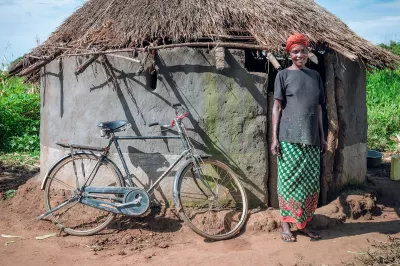Stuff Matters: Rethinking Value in Asset Finance
In May, the Economist ran a depressing headline: “Cheap illumination’s benefits in remote areas may be limited.” The paper was reporting on a study testing the socioeconomic impact of microgrid connections in India on kerosene savings, hours worked and starting new businesses. They found only a small reduction in kerosene spending and “no systematic evidence for changes in savings, spending, business creation, time spent working or studying, or other broader indicators of socioeconomic development.”
And that is disappointing, the researchers and the Economist seem to imply, because those are the metrics that really matter.
They are wrong.

Over the past four months, my colleague Anne Gachoka and I have spent much of our time listening to the stories and reflections of users of off-grid solar energy across four African countries for a new piece of CGAP and FIBR (an R&D project sponsored by Mastercard Foundation) research, "Escaping Darkness: Understanding Consumer Value in PAYGo Solar." One late afternoon, I sat down with a husband and wife under a tree on their farm in western Kenya. About three years ago, the husband had taken some money from his sugarcane harvest and invested in a solar system to light the main room of his home. This solar system did not save his family any money. It was expensive. Some might argue that he would be better off investing that money into something productive, maybe more farmland, goats, cows, starting a small business. Those are things with quantifiable returns.
His wife would disagree. When I asked the couple what they used to do when they had a cash flow shortfall and couldn’t buy kerosene, his wife leaned forward to tell us about giving birth at home on a night when they had no cash to buy kerosene. As culture demands, her husband left the house for the baby’s delivery, and she was left alone in total darkness. After delivering, she couldn’t see at all to clean the baby, so — still laying on her back — she reached around in the darkness until her hand touched a sweater. Then she reached for the matchbox and lit the clothing on fire just to see long enough to clean her newborn son.
The value of solar home systems our 138 respondents — much like for this couple — was not about saving money, generating income or improving children’s test scores. It wasn’t about saving money in the future for clinic visits for eye and lung problems caused by kerosene smoke, though all those things might be true for some. It wasn’t about just getting a loan or finding some use for mobile money, though both work together to bring solar lighting within financial reach for PAYGo clients.
They bought solar home systems because darkness is miserable. Solar home systems bring comfort, dignity and connection. Solar gave them better quality light, let them better see when walking outside, giving them peace of mind about security and helping them avoid snakes and other wildlife. Solar made them feel proud and modern; it turned their home into a space that was welcoming for visitors, a great honor in many African societies. It allowed them to regularly and conveniently charge their phones, listen to news on the radio and expose their children to the wider world through television.
Even if it’s hard to place a dollar sign next to those gains, don’t they still matter? When we talk about financial inclusion as a means to an end, aren’t these the ends we want to see people achieve?
A narrow focus on purely economic metrics, or the forms of value that reduce poverty in the future, blinds us to the forms of value that bring comfort and well-being today. For some that might be replacing thatch with a metal roof. For others, it may mean buying a blanket. In some communities, it means moving from a reed mat to a mattress. None of that stuff generates income. All of it makes life better. Those things are high on the spending priority lists of low-income families, because they do not only need tools that help them become less poor, but also stuff that make being poor less uncomfortable.
Well-designed credit, like PAYGo solar, can bring these kinds of highly valued assets within reach for many more people. And, yes, that credit adds costs and creates some level of risk for borrowers and lenders. It’s easy to dismiss this kind of lending as risky “consumption credit.” But especially when clients are telling us so loudly that that these things, this credit means so much, shouldn’t we — as donors, researchers and advocates — listen?




Comments
Dear Julie, Thank you so much
Dear Julie, Thank you so much for this great blog, which reminds all of us of the importance and urgency of fighting against poverty through micro financial services. Kazuto, JICA
Hello Julie,
Hello Julie,
Please have a look at a company called PowerHive. They currently work in Kenya and have started alongside the solar electrification of rural Kisii a micro-financing project that invests in new business opportunities for the villagers. So far the results have proven positive with regards to the conventional metrics utilized to measure "success" in such ventures and of course, as you say, the gain in additional value is immense.
FINCA is just wrapping-up a
FINCA is just wrapping-up a survey of over 700 customers who have purchased solar lanterns, solar home systems and improved cook-stoves. In both the qualitative and quantitative phases of the research, our data seem to be very in-line with this posting. The cash savings are low (though possibly not insignificant for those at the very bottom of our customer base). By contrast, the quality-of-life issues stand out very clearly, including more time for work and leisure, better health, comfort and safety. We'll be releasing these findings in the next month or so.
As one of the authors of the
As one of the authors of the Science Advances study you cite, I would note we conducted systematic tests on quality-of-life outcomes and female empowerment. More generally, to formulate good policy, we need more rigorous research and fewer anecdotes.
Add new comment